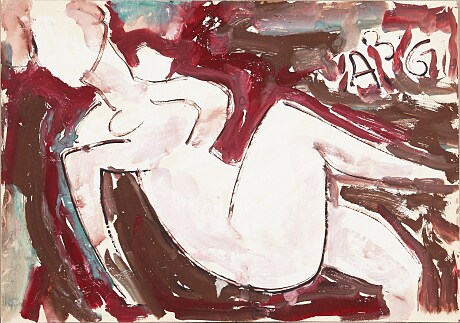HEJ!
Dåliga nyheter:
Auktionstipset har tyvärr kastat in handduken. Det har varit otroligt roligt att göra Auktionstipset, så kul att vi höll på i över fem år! Men nu är tiden kommen att ha otroligt roligt i någon annan kapacitet. Vi skrev ett långt brev i ämnet, om du vill veta mer.
Goda nyheter:
Du hittar oss på Arranging Things där vi fortsätter leta, välja, sourca, designa, köpa, sälja och i största allmänhet bara verkligen gilla grejer. Vi har ju även butik (både online och live) och instagram som du är mycket välkommen till!
Och om du bara vill spana på grejer kan vi också varmt rekommendera en tur här i Auktionstipsets arkiv, som har hunnit bli väldigt matigt och inspirerande.
Ja det var väl det. Stort tack för den här tiden! Det var verkligen något.
Och hör förstås av dig om du vill nåt!
Kram,
Lisa & Leo
Anatoli Zverev
 ANATOLI TIMOFEEVICH ZVEREV (1931-1986):. Model, signed with initials and dated 61, gouache on paper, ca 41,5x59 cm.. . PROVENANCE. Dimitri Apazidis, Stockholm, inherited to the current owner.. Acquired directly from the artist.. . Zverev was born in Moscow and attended the Moscow School of Art and Industry from 1948-1950. He was discovered while fence-painting in Sokolniki Park sometime in the early 1950s by dancer Alexander Roumnev. Roumnev saw talent in the young man and introduced him to prominent Moscow residents, notably the collector George Costakis who became a great promoter of Zverev's work. A shabbily-clothed vagrant who was given materials and food by his admirers, Zverev was the subject of exhibitions abroad in Europe and the United States due to his supportive circle of friends. His first exhibition took place at the Motte Gallery in Paris in 1965. Life magazine published one of his self-portraits, prompting Khrushchev into banning his contact with foreigners. Zverev, however, received immense praise from his artistic contemporaries including Pablo Picasso and Robert Falk, and he was popular with a foreign audience of diplomats and vistors to the Soviet Union. Frequently disappearing and reappearing, he died unexpectedly in 1986. His outsider status in Russia accounts for Zverev's lack of access to proper materials, so the artist worked only in what was available to him and produced works in a range of media including toothpaste and cigarette butts.. . Zverev was represented in the exhibition Times of Change: Art of 1960-85 in the Soviet Union at the State Russian Museum in 2006, and in contrast to his lifetime, posthumously his work has been continually exhibited in Russian museums.
ANATOLI TIMOFEEVICH ZVEREV (1931-1986):. Model, signed with initials and dated 61, gouache on paper, ca 41,5x59 cm.. . PROVENANCE. Dimitri Apazidis, Stockholm, inherited to the current owner.. Acquired directly from the artist.. . Zverev was born in Moscow and attended the Moscow School of Art and Industry from 1948-1950. He was discovered while fence-painting in Sokolniki Park sometime in the early 1950s by dancer Alexander Roumnev. Roumnev saw talent in the young man and introduced him to prominent Moscow residents, notably the collector George Costakis who became a great promoter of Zverev's work. A shabbily-clothed vagrant who was given materials and food by his admirers, Zverev was the subject of exhibitions abroad in Europe and the United States due to his supportive circle of friends. His first exhibition took place at the Motte Gallery in Paris in 1965. Life magazine published one of his self-portraits, prompting Khrushchev into banning his contact with foreigners. Zverev, however, received immense praise from his artistic contemporaries including Pablo Picasso and Robert Falk, and he was popular with a foreign audience of diplomats and vistors to the Soviet Union. Frequently disappearing and reappearing, he died unexpectedly in 1986. His outsider status in Russia accounts for Zverev's lack of access to proper materials, so the artist worked only in what was available to him and produced works in a range of media including toothpaste and cigarette butts.. . Zverev was represented in the exhibition Times of Change: Art of 1960-85 in the Soviet Union at the State Russian Museum in 2006, and in contrast to his lifetime, posthumously his work has been continually exhibited in Russian museums.